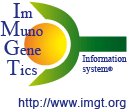Haploid hydatiform mole
A haploid hydatidiform mole is the tissue that develops when a sperm fertilizes an egg that has lost its DNA, and the sperm duplicates its own genome. This results in a growing mass of tissue, with vesicular chorionic villi, and no discernable fetal or embryonic development. It almost always ends in spontaneous abortion. In some cases, these moles can cause choriocarcinoma (cancer of the placenta).
Sequencing the moles is advantageous since they are haploid and therefore contain only one allele at each gene location. Thus, the CHORI-17 BAC library BACPAC Resources C.H.O.R.I (Children's Hospital Oakland Research institute) from which BAC clones were sequenced was constructed from a complete haploid hydatiform mole (BACPAC Resources Center).
Sequencing of the Homo sapiens IG and TR loci allows one distinguishing very similar genes from separate alleles of the same gene in multigene families. In the Homo sapiens GRCh38 genome assembly, the IG and TR loci were assembled from CH17 BAC clones from the CHORI-17 BAC library.



